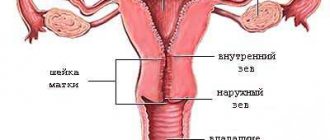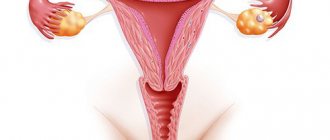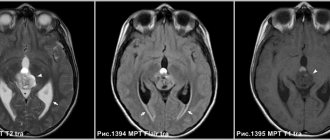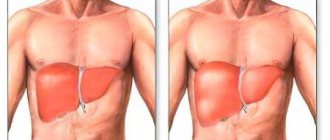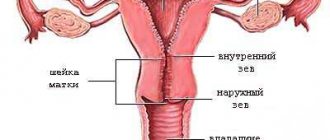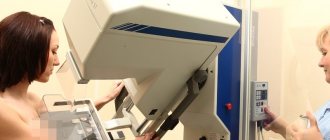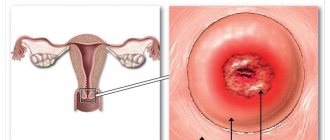Cervical cyst is a pathological disease caused by round-shaped neoplasms, the cavity inside is filled with liquid secretion. Usually, the cyst itself does not pose a threat to the health and life of a woman. A cyst located on the cervix can cause infection. This can lead to infertility and ectopic pregnancy. Most often, the pathology occurs in women of reproductive age. About 15% of women have cystic neoplasms.
One of the most common gynecological diseases is cervical cyst. Closed glands appear in the cervix, in which fluid accumulates. The inflammatory process originates in the vagina or uterine canal. Inflammation spreads to the excretory ducts. The glands become enlarged and filled with fluid produced. They are shaped like a drop, the size can be from 1 mm to 3 cm. The internal mucus is usually white or yellow.
What is a cervical cyst and the reasons for its appearance?
At its core, a cervical cyst is an enlarged, closed gland on the cervix in which secretions accumulate.
The cause of this disease is often hormonal and inflammatory processes. Cervical cysts can be either single or multiple. These cysts have another name - “Nabothian cysts”.
The formation of nabothian cysts is often associated with “self-healing” of cervical ectopia. In other words, cervical cysts are a kind of ectopia.
The development of this disease is based on blockage of the excretory ducts of the cervical glands, as a result of which a serous secretion of a dirty gray color begins to accumulate under a thin and transparent capsule.
There are many reasons for the appearance of cysts on the cervix, and it is not always possible to determine what exactly led to their formation.
The main factors contributing to the development of cysts on the cervix and inside it:
- childbirth;
- instrumental termination of pregnancy;
- sexual infections;
- changes in hormonal levels;
- wearing an intrauterine contraceptive device (IUD);
- cervical injury;
- inflammatory processes of the cervix (cervicitis);
- cauterization of the cervix with chemical means;
- metabolic disease;
- failure to comply with personal hygiene rules.
Causes of cervical cysts: disruption of outflow from the blocked gland of the cervix against the background of natural regeneration of the surface of the cervix.
According to statistics, cysts inside the cervix and on the uterus occur most often in women of reproductive age (15 out of 100), and less often in girls who began sexual activity early - from the age of 14.
Leading specialists in the treatment of uterine cysts in the Southern Federal District
Ermolaeva Elvira Kadirovna is a well-known and recognized specialist in the North Caucasus in the treatment of cervical cysts, nabothian cysts. She is a gynecologist, ultrasound doctor, physiotherapist-resortologist. Elvira Kadirovna is approached by women who want to improve the aesthetics of the genital organs, reduce the size of the vagina and refresh intimate relationships from all regions of Russia and foreign countries.
Ermolaev Oleg Yurievich Candidate of Medical Sciences, operating gynecologist with 25 years of successful experience in treating cervical cysts. Able to see relationships that elude others.
Shchepkin Petr Sergeevich Gynecologist, specialist in the treatment of cervical cysts, nabothian cysts. Experienced ultrasound doctor.
About the doctors of the Clinic in detail...
| INTERNATIONAL RECOGNITION of the reputation and achievements of the Women's Health Resort Clinic in the development and implementation of effective and safe treatment methods and the quality of medical services provided is the AWARDING of the Women's Health Resort Clinic in Pyatigorsk with the SIQS International QUALITY CERTIFICATE in the field of medicine and healthcare. International Socratic Committee, Oxford, UK and Swiss Institute for Quality Standards, Zurich, SWITZERLAND. |
The resort clinic for women's health operates both for paid services and in the voluntary health insurance system.
We work seven days a week and on holidays:
Monday - Friday from 8.00 to 20.00, Saturday, Sunday, holidays from 8.00 to 17.00.
Treatment of cervical cysts by appointment by multi-channel phone 8 (800) 500-52-74 (toll-free within Russia), or +7, or [email protected]
| ONLINE information about the treatment of uterine cysts can be found at: [email protected] REGISTER ONLINE for treatment of cervical cysts here. SIGN UP online for uterine cyst removal here. Buy coursework by phone +7 (928) 022-05-32 or here. |
Make an appointment with a gynecologist
The spa clinic for women's health facilitates the accommodation and accommodation of women, women with children and couples during examination and treatment.
Read more about the living conditions and transfer from Mineralnye Vody airport and Pyatigorsk railway station in the article “Accommodation”.
If you need to book accommodation, please coordinate your arrival date no later than 7 days in advance.
We are at your FULL DISPOSAL if you have any doubts or wishes.
Symptoms of a cervical cyst
Signs of a cervical cyst: in most cases there are no symptoms of its presence, and it is detected only during examination by a doctor.
Symptoms of a cervical cyst may occur due to its growth.
Cysts on the cervix may present with the following symptoms:
- pain in the lower abdomen;
- bleeding;
- pain during intercourse.
Inflamed cystic formations on the cervix manifest as follows:
- feeling of fullness and discomfort;
- discharge from the genital tract with an unpleasant odor - mucopurulent or purulent;
- severe pain in the lower abdomen;
- weakness, fatigue;
- rarely nervousness, irritability and headaches;
- temperature increase is more than 37.0;
- vaginal discomfort and itching.
The appearance of a cervical cyst against the background of endometriosis on the eve of menstruation and after it is accompanied by bleeding, blood during and after sexual intercourse, and sometimes uterine bleeding may occur.
Cervical cysts are detected by a doctor when examined in a speculum, because most often they are located on the surface of the organ. When examined in a speculum, a cyst of the cervix looks like a round formation measuring 1 to 2 cm with liquid contents inside. It happens that cervical cysts are not detected during examination, since they are located in the thickness of the tissue of the cervix or along the cervical canal. Cysts in endometriosis, unlike simple cysts, are brown in color.
Possible complications
Cysts of any etiology become a favorable environment for the development of infections and can trigger inflammatory processes in the ovaries, endometrium, fallopian tubes, and vaginal mucosa. Frequent relapses of pathological processes provoke the transition of diseases of the reproductive organs into a chronic form.
Particularly large formations or multiple small ones can block the cervical canal, which will significantly complicate the course of pregnancy. In addition, narrowing in the endocervix is an obstacle to the passage of sperm, and this may well interfere with conception.
Diagnosis and treatment
Treatment for cervical cysts is not difficult, but it is necessary. Timely treatment of cervical cysts will help avoid the development of other, more severe pathologies of the uterus.
Treatment of cervical cysts in our center is carried out only after a thorough colposcopy. The cervix is examined under a microscope to make sure that we are dealing with a Nabothian cyst and not another cervical pathology. After this, the cyst is punctured and its contents drain. The cyst bed is treated using radio waves using the drug Surhydron.
As a rule, patients are sent home on the same day. Sometimes for another 1-2 days they may be bothered by aching pain in the lower abdomen.
Also treatment of cervical cysts
combined with healing drugs that are applied topically in the form of suppositories (depanthol, etc.).
Treatment of cervical cysts is indicated in the first half of the menstrual cycle (in the second or first week after menstruation ends). Treatment of cervical cysts, as a rule, is not accompanied by additional care for the patient - a follow-up examination after 1-1.5 months is quite sufficient.
Contraindications
Surgical intervention in the treatment of cysts is contraindicated in the presence of an acute infectious process of the genitourinary organs, pregnancy at any stage and in the early postpartum period, severe somatic diseases in the stage of decompensation. It is recommended to postpone surgery in case of acute respiratory viral infections, acute respiratory infections, exacerbation of any concomitant chronic diseases, or during menstruation.
Gentle methods of cyst removal are contraindicated in cases of high risk of malignancy, diagnosis of precancerous pathology of the cervix, or large tumor formations that compress neighboring organs and impair their function.
Examination of patients with Nabothian cysts
In most cases, Nabothian cysts are detected during a gynecological examination using speculum. To clarify their nature, gynecologists at the Yusupov Hospital conduct additional research methods:
- Ultrasound examination of the pelvic organs with a transvaginal and transabdominal sensor (to exclude pathologies of the reproductive system);
- Colposcopy – allows you to examine cysts with optical magnification and special lighting;
- Cytological examination of mucus (smear) from the vagina, cervix and urethra - to determine the type of infection that caused the inflammation;
- Bacteriological culture - allows you to determine the sensitivity of bacteria to antibiotics that are prescribed to relieve the inflammatory process;
- PCR (detection of viral DNA) - to detect sexually transmitted infections (trichomoniasis, chlamydia, mycoplasma) and the presence of human papillomaviruses in a woman’s body.
They also perform a general blood test (to determine the number of leukocytes and erythrocyte sedimentation rate), examine the amount and ratio of hormones, the presence and level of tumor markers. Antibodies to sexually transmitted infections are determined using the ELISA (enzyme-linked immunosorbent assay) method.
Removal of nabothian cysts using the radio wave method
This is not a disease for which you need to panic and immediately begin treatment. First of all, listen to what the gynecologist says. Perhaps the doctor will decide that treatment is not needed at all, and we can limit ourselves only to observation over time.
If it is decided to remove the cyst, this can be done in different ways. For example, using an electrocoagulator or freezing with nitric oxide. The ProfMedLab clinic uses radio wave surgery.
During the procedure, the doctor uses an instrument that delivers high-frequency radio waves. They literally evaporate pathologically altered tissue. We prefer this method because it has some advantages:
- Removing cysts using radio waves is a quick procedure that can be performed quickly and does not require hospitalization.
- The effect is very precise, the doctor destroys only pathological tissues without damaging healthy ones.
- Minimal blood loss.
- There is no risk of deformation or stenosis (narrowing) of the cervix.
- Healing occurs quickly. After the procedure, you can go home almost immediately and do your usual activities.
- It does not hurt. Our doctors perform treatment under local anesthesia.
- The use of radio wave surgery makes it possible to perform a biopsy of a distant formation in doubtful cases.
At the ProfMedLab clinic, modern technologies and the professionalism of our doctors are at your service. We remove cervical cysts and other formations quickly, painlessly, and effectively. Come, we will help you get rid of your problem. Call: +7 (495) 120-08-07.
What danger does a polyp pose?
Most often, cervical polyps appear against the background of other diseases. They are not dangerous in themselves, but over time they can develop into a malignant tumor. The disease can also cause:
- anemia (due to large blood loss);
- even greater hormonal imbalance;
- miscarriage.
Often, due to the appearance of neoplasms in the cervical canal, it begins to be pinched. In this case, the patient needs to receive urgent surgical care.
If a cervical polyp is detected after pregnancy, there is no need to take urgent measures. During pregnancy, they increase slightly and, as a rule, do not interfere with the birth of the child. Remove growths after childbirth. The gynecologist involved in pregnancy management will monitor the dynamics of the development of the neoplasm and, if necessary, take the necessary measures to prevent premature birth.
Symptoms of the disease
The main symptoms that you should pay attention to and see a doctor are:
- Bleeding outside of menstruation.
- The pain is sharp and acute in the lower abdomen.
- Painful sensations during sexual intercourse.
- Vaginal discharge, if not accompanied by sexual arousal.
It is important to understand that these symptoms most often appear in the advanced stages of the disease. In the early stages of development, cysts do not manifest themselves, and therefore a woman needs to regularly visit a gynecologist for prevention.
Progress of the operation
Minimally invasive interventions are performed without anesthesia on an outpatient basis. It takes 10-15 minutes. The patient can go home the same day.
Conization of the cervix is performed with the participation of an anesthesiologist. After consultation, he establishes the anesthetic risk and selects anesthesia taking into account the individual characteristics of the woman. The scope of surgical treatment and excision technique are determined by the gynecologist depending on the extent of the pathological process. The excised tissues during the operation are sent for histological examination. The patient remains in the hospital for at least 1-2 days under the supervision of the attending physician.
Removal of polyps surgically
Polypectomy (cleaning the cervix of tumors) is performed using a hysteroscope. The equipment used during removal visualizes the surgeon’s actions, which reduces the risk of error to a minimum. This is a relatively new method of eliminating cervical polyps. Previously, they were gotten rid of by scraping, but this procedure is performed blindly. This increases the likelihood that the surgeon will not completely remove the growth. Remaining particles will quickly provoke a relapse. In addition, curettage is traumatic for the uterus and nearby organs.
You can remove cervical polyps with a laser. This is a minimally invasive method. The growth is removed pointwise. The method is safe and effective. There is no risk of damage to the reproductive organs during the operation. However, the cost of such treatment is more expensive than polypectomy.
Other methods are also used: cryodestruction, radio wave therapy, diathermocoagulation. They are less effective than polypectomy and curettage. Each method has advantages and disadvantages. When choosing, the specialist takes into account the nature and dynamics of the disease, the individual characteristics of the patient.
Varieties
Cystic formations can be:
- Endometriotic, which are formed from endometrial cells when it grows into the cervix.
- Nabothian cysts, which are formed as a result of pathological changes in the epithelium of the cervix or in the Nabothian glands.
Nabothian glands are special glands that produce mucus. It creates a plug that prevents infection from entering the uterus. If the glands are clogged, mucus accumulates, creating voids in the swollen glands.
Necessary tests and preparation for surgery
Before removing a cyst, the patient undergoes a full examination to clarify the origin, exclude infection and malignant process, and find out hormonal levels. To do this, the clinic doctor, after clarifying complaints, collecting anamnesis and gynecological examination, prescribes a number of clarifying tests and instrumental studies:
- extended colposcopy - examination of the vaginal mucosa of the cervix using a special magnifying device with vinegar and iodine tests;
- cervicoscopy – examination of the cervical canal through an endoscope;
- flora smears, atypical cells from different areas;
- bacterial culture and PCR examination of secretions and cyst contents aimed at detecting hidden infections;
- puncture, targeted biopsy followed by cytological and histological examination of the obtained material;
- Ultrasound of the pelvic organs using a vaginal sensor;
- in severe diagnostically unclear cases, CT and MRI are performed;
- blood tests for hormones, immunological status;
- consultation with an endocrinologist, oncologist, urologist if necessary.
Preparation for the operation is simple. For three days you need to avoid sexual intercourse and the use of barrier vaginal contraceptives and hygienic tampons. Observe personal hygiene rules. On the eve of surgery, exclude heavy fatty foods, gas-forming foods, coffee, alcohol, and smoking from the diet.
Causes
To date, no specific reason has been identified that provokes the growth of a cyst in the cervix. Experts identify several factors that can affect the growth of tumors:
- Concomitant diseases of the cervix, for example, the presence of erosions.
- Hormonal disbalance.
- Traumatic injuries to the cervix.
- Infectious or inflammatory processes of the reproductive system.
- Installation of an intrauterine device.
- Endocrine disorders.
